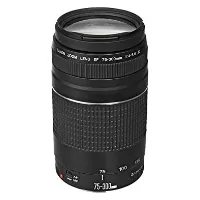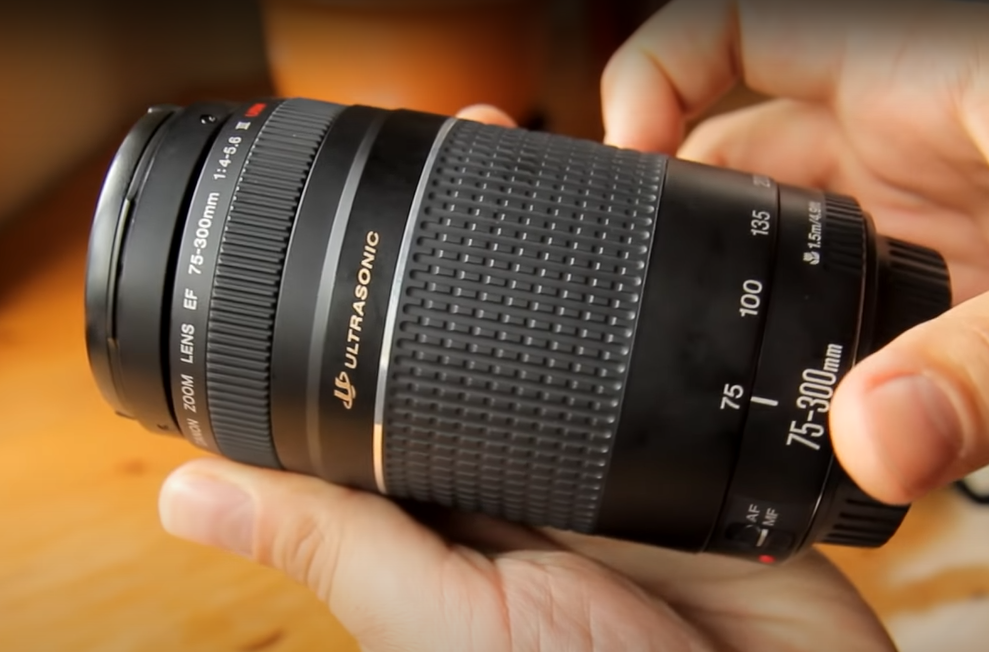Introduction
Cameras are no longer merely tools for recording memories. They have evolved into an essential instrument for expressing creativity, recording our surroundings, and even earning a job. A high-quality camera may open a world of possibilities for photography lovers, pros, and even amateurs. With the correct equipment, one may explore various photographic genres, experiment with various approaches, and take magnificent photographs that provoke emotions, tell a narrative, and inspire others.
The lens is an important part of any camera system. A decent lens may make or break the quality of your photos. If you want to improve your photography skills, a telephoto lens like the Canon EF 75-300mm is a fantastic choice. It’s ideal for wildlife photography, sports, and portraiture since it can zoom in on distant objects while compressing the backdrop. In this Canon EF 75-300mm review article, we’ll look at its features, and how it performs in our review to help you determine whether it’s the ideal tool for your photographic requirements.
Overview of Canon EF 75-300mm
Canon is a world-renowned maker of cameras, lenses, printers, and other image products. In 1937, the firm was started in Tokyo, Japan, to produce high-quality cameras to make photography accessible to everyone. The Kwanon, named after the Buddhist goddess of kindness, was Canon’s first camera and featured the world’s first 35mm focal-plane shutter.
The Canon EF 75-300mm lens, launched in 1995, has received various modifications and enhancements. Its lightweight and small form makes it a perfect choice for photographers who don’t want to tote about bulky equipment but want to produce high-quality photographs. The Canon EF 75-300mm lens is popular among photographers who want to improve their telephoto skills. This lens, with a focal length range of 75mm to 300mm, is great for photographing distant objects such as animals, sports, or portraiture.
Key Specifications Canon EF 75-300mm
| Brand | Canon |
| Focal Length Description | EF 75-300mm f/4-5.6 III |
| Lens Type | Telephoto |
| Compatible Mountings | Canon EF |
| Camera Lens | 300mm |
| Minimum Focal Length | 75 mm |
| Lens Zoom | Zoom |
| Focus Type | Micro-type Ultrasonic |
Canon EF 75-300mm Key Features
Canon EF 75-300mm

- Autofocus
- Covers Full-Frame Sensor
Now that you know about Canon’s key specs, history, and origin, it’s time we start learning about the Canon EF 75-300mm key features. Let’s review some of the main features in detail:
1. Image Quality
The Canon EF 75-300mm telephoto zoom lens produces crisp, clean photos with exceptional detail and color reproduction. This lens’ maximum aperture range of f/4-5.6 enables shooting in various lighting settings, making it a flexible option for several photographic genres.
The lens comprises 13 elements organized into nine groups, which helps prevent chromatic aberration and other distortions that may degrade the picture quality. Whether photographing portraits or animals, the Canon EF 75-300mm creates clean and vivid photographs, making it an excellent option for both amateurs and pros.
2. Aperture
The maximum aperture range of the Canon EF 75-300mm lens is f/4-5.6, which means it isn’t the quickest lens in low-light capabilities. On the other hand, the aperture range is more than suitable for most outdoor shooting situations, including sports, wildlife, and landscape photography.
The broad aperture range of the lens also allows for selective focus, resulting in a narrow depth of field that may be utilized to separate objects from the background. The lens’s 58mm filter size allows it to be used with various filters, including polarizers and neutral density filters, providing photographers with more creative control over their photos.
3. Zooming
The zooming capabilities of the Canon EF 75-300mm are one of its standout qualities. This lens’ focal length range of 75-300mm enables you to photograph distant scenes without losing picture quality. The revolving zoom mechanism is smooth and simple, allowing photographers to alter the focus length for the ideal image swiftly.
The lens’s close-focusing distance of 4.9 feet is astounding, enabling a subject the size of a dollar note to fill the frame at 300mm. The Canon EF 75-300mm’s zooming capabilities make it a trustworthy and adaptable tool for photographers, whether you’re catching animals in motion or portraiture at a distance.
4. Image Stabilization
The Canon EF 75-300mm lacks built-in image stabilization, which might be a drawback when shooting in low light or with slower shutter rates. However, the lens’s broad aperture range and rapid AF capability allow clear shots to be captured without image stabilization. Furthermore, the lens is compatible with Canon’s external image stabilization devices, such as the Canon EF 1.4X III and EF 2X III extenders, which may be connected to the lens for further stability.
5. Auto and Manual Focus
The Canon EF 75-300mm lens’s DC motor’s autofocus system ensures quick and accurate focusing. Low-light photography might be hampered by the autofocus’s relative lack of silence compared to Canon’s USM technology.
The lens also has a manual focus ring that may be used to fine-tune focus and give the photographer more leeway in composition. Those who like to use manual focus will appreciate the ring’s silky smoothness and user-friendliness.
6. Telephoto Zoom Lens
The Canon EF 75-300mm telephoto zoom lens is intended for photographing faraway objects. The lens’s 75-300mm focal length range is great for shooting distant animals, sports, and portraits, making it a popular option among photographers looking to enhance their telephoto skills. The lens’s small and lightweight form makes it simple to transport, and its solid construction provides longevity even under difficult shooting situations.
7. Build Form
The Canon EF 75-300mm f/4-5.6 III Telephoto Zoom Lens is designed to endure daily use. Its small size and low weight make it a great travel companion for anyone wishing to photograph beautiful scenery or animals. The lens is 2.8 inches in diameter and 4.8 inches long, making it small enough to fit in a camera bag or backpack.
Pros
- Autofocus
- Covers Full-Frame Sensor
Cons
- No Weather Sealing
Conclusion
If you’re a photographer searching for a flexible, dependable, and high-quality lens, go no further than the Canon EF 75-300mm f/4-5.6 III Telephoto Zoom Lens. It stands out from similar lenses because of its remarkable zoom range, large aperture, and high-quality images.
The lens’s small and durable design makes bringing it along on your travels convenient. The focal length may be precisely adjusted with no jarring motions thanks to the zoom system’s smooth and effortless rotation. The lens may be used with various Canon SLR cameras, expanding your options for when you need to use it.

